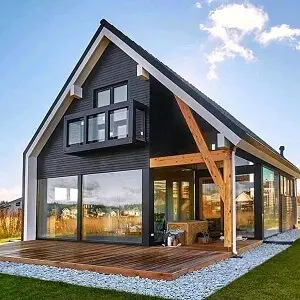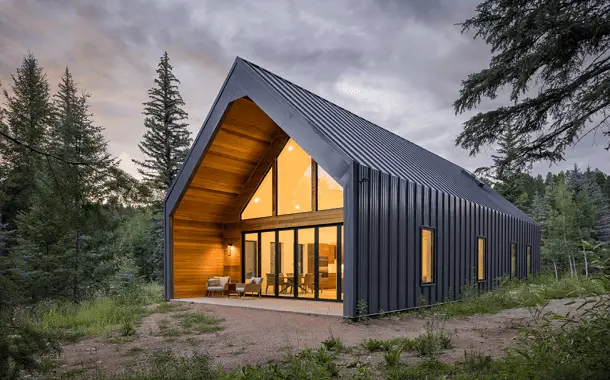How Much Does a Smart Cottage Cost?
Last Updated on February 15, 2024
Written by CPA Alec Pow | Content Reviewed by ![]() CFA Alexander Popinker
CFA Alexander Popinker
Smart cottages have become an increasingly popular housing option for their efficiency, sustainability, and integration of smart home technology. But how much does it actually cost to build or buy one of these high-tech, eco-friendly compact homes? In this article, we’ll break down the typical price range for smart cottages and the many factors that influence the final cost.
How Much Does a Smart Cottage Cost?
The overall price to build or buy a smart cottage can range quite a bit, generally between $80,000 to $250,000. But what makes up these costs?
For new construction, factors like size, materials, technology packages, and customization play important roles. Larger smart cottages with higher-end finishes and abundant smart features will sit at the top of the range, while smaller, more basic prefab models can cost much less.
Construction Costs for Smart Cottages
Constructing a new smart cottage from scratch involves costs including:
- Land purchase – Buying property for the home. Costs vary greatly by location.
- Permits and fees – Includes permitting costs, impact fees, utility hookup fees. Typically, a few thousand dollars.
- Foundation – Smart cottages may use standard foundations or other options like piers or an integrated chassis with prefab construction. This portion can run $15,000 to $30,000.
- Framing and roofing – Traditional wood or metal stud framing. Roof may be gable, hip, or shed style. Budget $15,000 to $35,000 for this stage.
- Outer shell – Installation of exterior siding, windows, doors. Vinyl, metal, composite, and wood siding are common options. Plan $20,000 to $50,000 for the shell.
- Insulation – Proper insulation like spray foam is essential in an energy-efficient home. Allow $5,000 to $15,000 for insulation.
- Utilities – Electrical, HVAC/heat, plumbing systems. Smart cottages emphasize energy-efficient options here. Allocate $15,000 to $35,000 for utilities.
- Interior finishes – Drywall, paint, trim, cabinets, countertops. Keep finishes simple to save costs. Budget $10,000 to $30,000.
- Smart home technology – Home automation system, lighting, appliances, etc. This can involve an extra $5,000 to $30,000.
- Labor – Builder and sub-contractor fees for construction should be factored in as well.
As you can see, costs add up quickly. Prioritizing simplicity and having a smaller footprint helps make smart cottages more affordable to build.
What About Prefab Smart Cottages?
Prefabricated, modular smart cottages are a more budget-friendly option, ranging from $80,000 to $150,000. With prefab, the home is constructed off-site in a factory using assembly line techniques, then delivered in modules to your property. This optimized process can cut construction costs 20% to 30% versus building custom on-site.
Prefab smart cottage providers have model designs to choose from that incorporate energy efficiency and smart tech features. And even further savings are possible by opting for more basic options without expensive customizations. The downside is less flexibility to fully customize the home’s design and features.
The cost of a Smart Cottage, as provided by Smart Cottage Homes, varies based on the specific model and configuration. So, according to their website, the cost for a Multi Mansion Smart Cottage ranges between $165,365.00, for a 2 Bedroom 2 Bath, 1000 Sq. Ft., and $184,136.00, for a 3 Bedroom 2 Bath, 1292 Sq. Ft.
An Introduction to Smart Cottages
But what exactly is a smart cottage? These intelligent, automated homes are generally smaller cottages or tiny houses, ranging from 400 to 1,000 square feet.
They incorporate smart home devices and systems to control lighting, climate, security, appliances, and more through home automation and the Internet of Things (IoT).
Smart cottages also aim to be eco-friendly through energy-efficient construction, green building materials, and renewable energy sources. The appeal lies in their intelligent use of space, convenience, sustainability, and affordability compared to larger homes.
For those looking to downsize or have a vacation home with a small footprint, smart cottages are an appealing option.
Features of Smart Cottages
Now that we’ve looked at the construction costs, let’s examine some of the defining features that make a cottage “smart” and enhance livability.
Smart Home Automation – These systems automate and integrate control of lighting, climate, appliances, security and more through home automation devices like sensors, switches and a central hub or control panel. Convenient voice control is available through AI assistants like Alexa.
Energy Efficiency – With a small footprint to heat and power, smart cottages emphasize insulation, air sealing, LED lighting and efficient appliances to lower energy costs. Some even produce their own solar or geothermal power.
Sustainable Materials – Green materials like recycled composites, Forest Stewardship Council (FSC) certified lumber and toxin-free paints help minimize environmental impact.
You might also like our articles about the cost of building a shouse, a brick house, or using LP SmartSide siding.
Space-Saving Designs – Careful space planning allows smart cottages to feel open and spacious while keeping square footage in check. Features like lofted bedrooms, multi-functioning furnishings and compact appliances help maximize use of the small floor plan.
Smart Security – Automated features like video doorbells, motion sensors, and cameras connected to a control panel or mobile app provide home security and monitoring.
Connectivity – Smart cottages come equipped with strong broadband internet to enable smart features, streaming entertainment and working from home. Connectivity is essential.
Comparing Prefab vs. Custom Smart Cottages
How do costs stack up between prefabricated vs. custom-built smart cottages? Here’s a look:
Prefabricated Smart Cottages
- Cost – $80,000 to $150,000
- Build Time – 4 to 6 months is typical
- Customization – More limited; choose from set floor plans and upgrade options
- Pros – Faster and 20-30% cheaper than custom building. Still get smart tech features.
- Cons – Less flexibility for layouts and personal custom touches. Need land already.
Custom Smart Cottages
- Cost – $150,000 to $250,000+
- Build Time – 10 to 14 months from design to completion
- Customization – Fully customize layout, finishes, features to your preferences
- Pros – Personalized smart cottage designed just for you.
- Cons – Longer build time. Significantly higher cost than prefab.
Custom building allows full creative freedom but carries a heftier price tag. Prefab balances smart tech with affordability through semi-custom designs at a lower cost.
Smart Home Technology in Cottages
Smart technology is integral to these intelligent homes. Here are some of the most popular smart systems found in smart cottages:
- Smart lighting – Automated LED lighting controlled through wall panels, mobile apps or voice activation. Dimmers, color tuning, and scheduling help save energy.
- Climate control – Smart or programmable thermostats optimize heating and cooling. Some cottages even have zoned climate control.
- Smart appliances – WIFI-enabled appliances can be controlled and monitored remotely via apps for convenience.
- Voice assistants – AI helpers like Amazon Alexa allow hands-free voice control of many home systems and devices.
- Integrated security – Features like security cameras, smart locks, motion sensors and lighting controls boost safety.
- Energy monitoring – Real-time tracking of energy use through a control panel or app promotes conservation.
- Multi-room audio – Music and audio can be streamed wirelessly throughout the cottage.
- Motorized windows – Automated smart windows provide natural ventilation on demand.
Home automation makes cottage living incredibly convenient while maximizing efficiency. Most systems can be controlled through a central smart home dashboard as well.
Budgeting and Planning Your Smart Cottage
 What’s the best way to plan and budget for your dream smart cottage? Here are some top tips:
What’s the best way to plan and budget for your dream smart cottage? Here are some top tips:
- Define your must-have features and nice-to-haves to help shape your budget. Prioritize needs versus wants.
- Research prices for both prefab and custom-building options in your target location.
- Get quotes from multiple builders to compare costs. Many provide free consultations.
- If building custom, find an architect experienced in small, efficient home design to optimize the layout and features.
- Choose more affordable finishes and facades to lower building costs. You can always upgrade later.
- Explore energy rebates and incentives in your area to offset technology costs.
- Consider financing options like construction loans or home equity loans to fund the build.
- Add a 10-20% buffer to your construction budget for unexpected overages.
Final Words
Smart cottages provide homeowners with the ideal combination of intelligent automation, energy efficiency, and sustainable living in a compact, affordable package.
While building costs are impacted by size, finishes, degree of customization and smart tech features included, you can expect to invest $80,000 to $250,000 for a smart cottage. Opting for a prefabricated model can yield significant savings compared to a fully custom build.
With careful planning and budgeting, plus utilization of green incentives where possible, realizing your dream of an automated, high-tech cottage lifestyle is within reach.
These modern, efficient small homes deliver capabilities and experiences that were once only found in luxury homes in a more attainable way.
Frequently Asked Questions
What are the disadvantages of cottages?
Some potential disadvantages of living in a cottage include:
- Smaller square footage and limited storage space compared to larger homes. This requires living with fewer possessions.
- Potentially less privacy depending on the lot size and proximity to neighbors.
- Limited options for entertaining large groups of people comfortably.
- Appreciation in value may be less than larger homes over time.
- Limited space for hobbies, workshops or multiple cars.
- Yard maintenance is still required even with a smaller footprint.
- Accessibility challenges for those with mobility issues due to compact multi-level designs.
What is the smallest modular home you can buy?
The smallest modular homes, often called tiny houses, typically range from 100 to 400 square feet. Within this range, some examples of tiny prefab modular homes include:
- 150 square feet – enough for a main living/sleeping space with bathroom and kitchenette.
- 300 square feet – can accommodate a main living area, small kitchen, bathroom, and lofted sleeping space.
- 400 square feet – allows for a bit more room for a bedroom, living room, kitchen and bath.
While challenging for some, tiny modular homes appeal to those wanting a simpler, minimalist lifestyle.
Is modular design cheaper?
Yes, modular design generally provides a more affordable option compared to traditional construction, with potential cost savings of 20-30%. This is achieved through:
- Assembly line style construction in a controlled factory setting.
- Ability to scale production and benefit from bulk material purchases.
- Lower labor costs by utilizing factory workers versus on-site sub-contractors.
- Faster construction timelines, reducing interest payments.
- Simplified on-site work for foundations, utilities and unit installation.
However, modular homes still have upfront building costs and customization results in higher prices. But overall, they can yield a lower price per square foot versus conventional construction.


Leave a Reply
Want to join the discussion?Feel free to contribute!